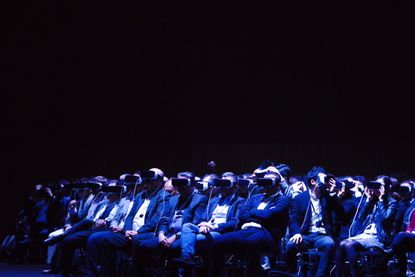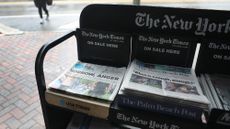How groundbreaking art is already emerging from virtual reality
A trio of groundbreaking VR installations at the Tribeca Film Festival hint at the staggering range of possibilities for this young art form


Last week, over the course of a couple hours, I spent some time in solitary confinement. And then I stepped into the shoes of a blind man gradually learning to navigate the world without sight. And then I went to a wildlife reserve, where I stood face-to-face with one of the world's last surviving northern white rhinos.
Such is the promise of virtual reality — a long-imagined technology that is beginning, at long last, to feel like an actual thing. The Oculus Rift is in the wild (though you might have trouble finding one). The similarly pitched HTC Vive is hot on its heels, with a projected ship date of June 2016 in the United States. Next fall, Sony will make an aggressive launch into virtual reality with the Playstation VR, a headset designed for the Playstation 4. And barring all those high-tech options, you can always fall back on something like Google Cardboard, which uses smartphones and cardboard binoculars to approximate the VR experience for around $15.
But however you end up experiencing it, the creative side of virtual reality is still in its infancy — and as with any new storytelling medium, there are a host of eager creators looking for new ways to harness it. Much of the focus has been on the future of gaming — platformers, racing games, RPGs, and even a massively multiplayer online game, all designed to immerse a player even more deeply in a digital world. (VR pornography has, perhaps unsurprisingly, drawn a disproportionate level of interest.)
Subscribe to The Week
Escape your echo chamber. Get the facts behind the news, plus analysis from multiple perspectives.

Sign up for The Week's Free Newsletters
From our morning news briefing to a weekly Good News Newsletter, get the best of The Week delivered directly to your inbox.
From our morning news briefing to a weekly Good News Newsletter, get the best of The Week delivered directly to your inbox.
But the most interesting work being done isn't confined to the realm of entertainment. In fact, it's pretty much the opposite; a series of unpleasant or even painful experiences, designed to imbue the player with a deeper sense of empathy for a problem that isn't their own. The Tribeca Film Festival's Storyscapes section features a wide range of VR experiences: a surreal narrative about a detective following a series of arrows through the desert, or a charming, child-friendly romp through a magical forest. But it's in the more harrowing experiences that Tribeca's emerging storytelling showcase feels truly groundbreaking.
6x9: An Immersive Experience of Solitary Confinement, which was created by a team from The Guardian, attempts to approximate the feeling of being in solitary confinement at a maximum-security prison. As you strap in, you find yourself sitting on a hard bed in the corner of a prison cell. As you look around, it takes about 10 seconds to see all there is to see: a sink, a toilet, and a shelf with a couple of dog-eared books. And then you sit, contemplating the monotony over monologues from real-life former prisoners who spent months or years in solitary confinement. As 6x9 continues, the auditory and visual hallucinations that are common symptoms of real-life solitary confinement begin to manifest: There's a persistent grumble in your ears, a nauseating moment in which you begin to float over the bed, and a humanlike figure appearing on the periphery of your vision, only to disappear every time you attempt to look at it directly. Of course, a nine-minute virtual reality experience couldn't possibly replicate the actual experience of spending months or years locked in solitary confinement. But the sheer discomfort of that brief experience is enough to make you contemplate how much worse it would be if those minutes were years.
Notes on Blindness: Into Darkness is a comparatively gentler experience, though no less affecting. The project is an attempt to approximate the experience of John Hull, an academic who went blind in 1983. In six brief installments culling material from Hull's real-life audio diaries, you are forced to contemplate the various realities of Hull's situation: the joy of "seeing" through the sound of rain hitting the world around you, the fear of getting lost on a walk without vision to guide you back to the path, and the question of whether your inability to see your children has affected your ability to understand them. Sometimes the experience is frustrating; sometimes the experience is beautiful. But Notes on Blindness never stops being immersive, putting you into a point of view that would be functionally impossible for any other medium.
It's here that you can see another possible use for VR: cultural preservation. Like Werner Herzog's Cave of Forgotten Dreams — a documentary that uses 3D to give viewers an approximation of what it's like to spend time looking at the 32,000-year-old cave paintings in France's Chauvet Cave, which has long been closed to the public — The Ark is poised to be a valuable cultural document in its own right, establishing a permanent record of an animal that's almost gone.
Sign up for Today's Best Articles in your inbox
A free daily email with the biggest news stories of the day – and the best features from TheWeek.com
I walked away from Storyscapes exhausted, rattled, and exhilarated by the storytelling possibilities of virtual reality. It is fundamentally immersive, occupying a point-of-view so completely that it's practically engineered to generate empathy. It is fundamentally personal, ensuring that each person will have a different experience, based on who they are and what they choose to focus on. And the technology itself, which covers the eyes and ears, necessarily prevents you from being distracted by anything that might pull you out of the experience. Those unique qualities, when combined, create a set of circumstances that are uniquely powerful, and it's dizzying to imagine what could be done with it when the barriers to entry are lowered for both users and creators. This is the path of any new art form; once you get a taste for what you can really do with it, it's impossible to stop thinking about what it might eventually become.
Scott Meslow is the entertainment editor for TheWeek.com. He has written about film and television at publications including The Atlantic, POLITICO Magazine, and Vulture.
-
 'Admission of error, or even of uncertainty, should make the public trust us more'
'Admission of error, or even of uncertainty, should make the public trust us more'Instant Opinion Opinion, comment and editorials of the day
By Justin Klawans, The Week US Published
-
 Today's political cartoons - November 5, 2024
Today's political cartoons - November 5, 2024Cartoons Tuesday's cartoons - mark your calendars, a relief, and more
By The Week US Published
-
 'Wolf Hall: the Mirror and the Light' season two – still a "crown jewel"
'Wolf Hall: the Mirror and the Light' season two – still a "crown jewel"The Week Recommends Damian Lewis and Mark Rylance star in this 'superlative' Tudor drama on BBC One
By Adrienne Wyper, The Week UK Published